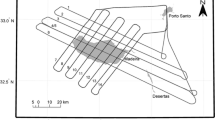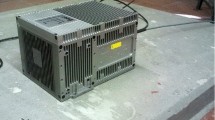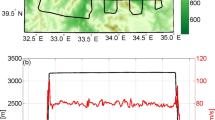Abstract
For the past two decades, airborne gravimetry using a Strapdown Inertial Measurement Unit (SIMU) has been producing gravity estimates comparable to the traditional stable-platform single-axis gravimeters. The challenge has been to control the long term drift of the IMU sensors, propagating into the long-wavelengths of the gravity estimates. This has made the stable-platform approach the preferred method for geodetic applications. In the summer of 2016, during a large airborne survey in Malaysia, a SIMU system was flown alongside a traditional LaCoste&Romberg (LCR) gravimeter. The SIMU observations were combined with GNSS observations using the commercial software product “Inertial Explorer” from NovAtel’s Waypoint software suite, and it is shown how gravity estimates can be derived from these results. A statistical analysis of the crossover differences yields an RMS error of 2.5 mGal, which is comparable to the results obtained from the LCR gravimeter. The properties of the SIMU and LCR systems are compared and a merging of the two is performed. A statistical analysis of the crossover differences of the merged product yields an RMS error of 1.3 mGal. These results indicate that the properties of the two units are complementary and that a combination of the two can result in improved gravity estimates.
Similar content being viewed by others
References
Andersen O, Knudsen P, Stenseng L (2015) The DTU13 MSS (mean sea surface) and MDT (mean dynamic topography) from 20 years of satellite altimetry. Springer, Berlin, Heidelberg, pp 1–10. doi:10.1007/1345_2015_182, http://dx.doi.org/10.1007/1345_2015_182
Becker D (2016) Advanced calibration methods for strapdown airborne gravimetry. PhD thesis, Technische Universität Darmstadt, Darmstadt. http://tuprints.ulb.tu-darmstadt.de/5691/
Becker D, Becker M, Leinen S, Zhao Y (2015a) Estimability in strapdown airborne vector gravimetry. Springer, Berlin, Heidelberg, pp 1–5. doi:10.1007/1345_2015_209, http://dx.doi.org/10.1007/1345_2015_209
Becker D, Nielsen JE, Ayres-Sampaio D, Forsberg R, Becker M, Bastos L (2015b) Drift reduction in strapdown airborne gravimetry using a simple thermal correction. J Geodesy 89(11):1133–1144. doi:10.1007/s00190-015-0839-8, http://dx.doi.org/10.1007/s00190-015-0839-8
Brown RG, Hwang PYC (2012) Introduction to random signals and applied Kalman filtering: with MATLAB exercises, 4th edn. Wiley, New York
Brozena JM (1992) The greenland aerogeophysics project: airborne gravity, topographic and magnetic mapping of an entire continent. Springer, New York, NY, pp 203–214. doi:10.1007/978-1-4613-9255-2_19, http://dx.doi.org/10.1007/978-1-4613-9255-2_19
Deurloo R (2011) Development of a Kalman filter integrated system and measurement models for a low-cost strapdown airborne gravimetry system. PhD thesis, Department of Geosciences, Environment and Planning, Faculty of Sciences, University of Porto
Glennie C, Schwarz KP (1999) A comparison and analysis of airborne gravimetry results from two strapdown inertial/dgps systems. J Geodesy 73(6):311–321. doi:10.1007/s001900050248, http://dx.doi.org/10.1007/s001900050248
Glennie CL, Schwarz KP, Bruton AM, Forsberg R, Olesen AV, Keller K (2000) A comparison of stable platform and strapdown airborne gravity. J Geodesy 74(5):383–389. doi:10.1007/s001900000082, http://dx.doi.org/10.1007/s001900000082
Groves PD (2013) Principles of GNSS, inertial, and multisensor integrated navigation systems, 2nd edn. Artech House Remote Sensing Library, Boston
Huang Y, Olesen AV, Wu M, Zhang K (2012) Sga-wz: a new strapdown airborne gravimeter. Sensors 12(7):9336–9348. doi:10.3390/s120709336, http://www.mdpi.com/1424-8220/12/7/9336
Jekeli C (1994) Airborne vector gravimetry using precise, position-aided inertial measurement units. Bull géodésique 69(1):1–11. doi:10.1007/BF00807986, http://dx.doi.org/10.1007/BF00807986
Jekeli C (2001) Inertial navigation systems with geodetic applications. Walter De Gruyter, Berlin
Jekeli C, Kwon JH (1999) Results of airborne vector (3-d) gravimetry. Geophys Res Lett 26(23):3533–3536. doi:10.1029/1999GL010830, http://dx.doi.org/10.1029/1999GL010830
Maybeck PS (1979) Stochastic models, estimation and control, vol 1. Academic, New York
Olesen AV (2002) Improved airborne scalar gravimetry for regional gravity field mapping and geoid determination. PhD thesis, Faculty of Science, University of Copenhagen
Olesen A, Forsberg R (2007) Airborne scalar gravimetry for regional gravity field mapping and geoid determination. In: Proceedings, Gravity Field of the Earth – 1st Meeting of the International Gravity Field Service, vol. 73, issue 18, 28th August–1st September, 2006. Harita Dergisi, Istanbul, pp 277–282.
Schwarz KP, Colombo O, Hein G, Knickmeyer ET (1992) Requirements for airborne vector gravimetry. Springer, New York, NY, pp 273–283. doi:10.1007/978-1-4613-9255-2_25, http://dx.doi.org/10.1007/978-1-4613-9255-2_25
Thompson LGD (1959) Airborne gravity meter test. J Geophys Res 64(4):488–488. doi:10.1029/JZ064i004p00488, http://dx.doi.org/10.1029/JZ064i004p00488
Torge W (1989) Gravimetry. De Gruyter, Berlin
Valliant HD (1992) The LaCoste and Romberg air/sea gravimeter: an overview. In: CRC handbook of geophysical exploration at sea. Hydrocarbons, 2nd edn. CRC Press, Boca Raton, FL, pp 141–176
Wei M, Schwarz KP (1998) Flight test results from a strapdown airborne gravity system. J Geodesy 72(6):323–332. http://dx.doi.org/10.1007/s001900050171
Acknowledgements
The airborne survey in the South China Sea was done as part of the Marine Geodetic Infrastructure in Malaysian Waters (MAGIC) project on behalf of Info-Geomatik Sdn. Bhd. and the Department of Survey and Mapping Malaysia (JUPEM).
Author information
Authors and Affiliations
Corresponding author
Editor information
Editors and Affiliations
Rights and permissions
Copyright information
© 2017 Springer International Publishing AG
About this paper
Cite this paper
Jensen, T.E., Nielsen, J.E., Olesen, A.V., Forsberg, R. (2017). Strapdown Airborne Gravimetry Using a Combination of Commercial Software and Stable-Platform Gravity Estimates. In: Vergos, G., Pail, R., Barzaghi, R. (eds) International Symposium on Gravity, Geoid and Height Systems 2016. International Association of Geodesy Symposia, vol 148. Springer, Cham. https://doi.org/10.1007/1345_2017_9
Download citation
DOI: https://doi.org/10.1007/1345_2017_9
Published:
Publisher Name: Springer, Cham
Print ISBN: 978-3-319-95317-5
Online ISBN: 978-3-319-95318-2
eBook Packages: Earth and Environmental ScienceEarth and Environmental Science (R0)




